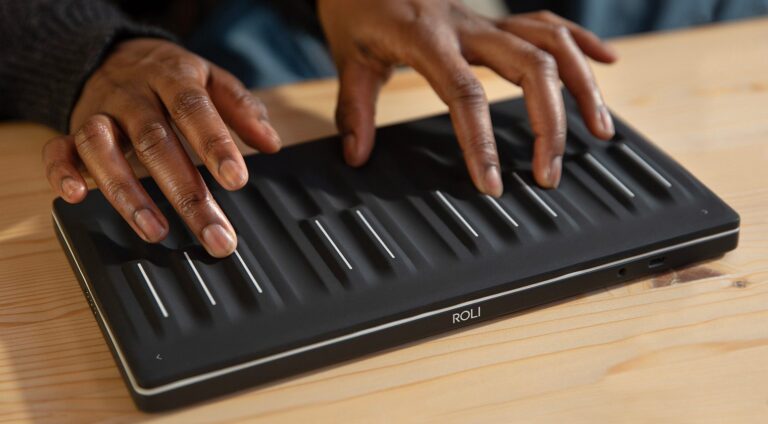Last Updated on March 11, 2024 by IDS Team
MPE is one of the most significant developments in synthesis since the introduction of digital. Yet still, many musicians still find themselves wondering ‘what is mpe’ or ‘what does mpe stand for?’ when they see it listed on a synth. So, if you may have seen the term ‘midi polyphonic expression’ and are unsure about what it actually means, his article is your crash course.
Here, we will break down common questions like ‘what is mpe midi’ and ‘how does mpe work?’ as well as going deeper into the best compatible gear out there and when and why you might use it, so read on…
What is MPE?
What is MPE? MPE, standing for midi polyphonic expression, is one of the latest innovations in synthesis since the development of digital FM synths. However, MPE is not a kind of synthesis. Instead it is a way of playing that makes synths sound more like actual instruments.
How does it do this? MPE gives the musician control over specific parameters of individual notes such as velocity, glide, aftertouch, and so on. It is these qualities that give music an analog, human-like feel, even if it was digitally created.
When MPE first burst onto the scene with the brand Haken, it was unclear as to whether it would catch on. However, MPE has come a long way since then. It now spans a range of instruments from controllers to digital VSTs to full-fledged synths at more affordable prices. Read on for the breakdown.
What Can MPE Do?
MPE can apply all the parameters when you play a non-synthesized instrument. This are things such as string bending, velocity, aftertouch, individual note loudness, and so on – to individual synthesized notes.
In case you’re not sure why this is a big deal, at one point this was very difficult to do on a synth. If you wanted to pitch bend, for example, you could use a pitch bending wheel. However, this would apply the bend to all the notes. So, if you were playing a chord, every note would be bent. This led to synthesized music being obviously that – and could sometimes be clunky compared to playing an actual instrument.
No more. MPE brought in the intuitiveness of playing a physical instrument, to synthesis. Now these minute details and expressiveness could apply to individual notes, bringing the warmth and human character to synthesis that some might have felt it was lacking.
Why might you want to use it?
At first, some musicians thought midi polyphonic expression might just be a gimmick. However, as time wore on, it has become a relatively embedded part of playing. It enables you to play synths like you would a stringed instrument or piano, which is no small feat. The differences between MPE and non-MPE might not seem easy to hear at first, but in the end, there is an expressiveness lacking from tracks that don’t have it – and some of the weird sounds, layers, and textures you can get from midi polyphonic expression enable you to take synthesis to new territory.
In short, MPE is great for:
- Creating solo lines that sound like a guitar or violin
- Experimental music
- Layering sound and creating texture
- Blending with real instruments
- Making synthesis sound more human
The Story of MPE and Equipment Guide
You may also find yourself wondering about mpe equipment, or ‘what is mpe ableton’ and if it is the same. Likewise, if you want mpe explained, it helps to know this process operates across VSTs, hardware instruments, AND specific controllers.
MPE in Ableton does refer to the same technique. It merely shows the popular DAW is mpe compatible, especially with mpe controllers. These are ways of adding midi polyphonic expression to your tracks and to instruments that don’t have a built-in expressive keyboard.
At the most basic level, MPE controls are quite fiddly and expensive for synth manufacturers to build into their machines. This is doubly difficult if you don’t have a keyboard on your machine, as is the case with many desktop synths.
Here comes the MPE controller. You may have heard of machines like the ROLI Seabord series or Linnstrument, but what do these controllers actually do? Simply put they are keyboards (in the broadest sense, for not all of them follow the black and white keyed layout of a classic midi keyboard) that you can hook up to your computer. In this way you are able to control a VST synth, or hook up to a hardware synth to control it that way.
Beyond the ubiquitous controller, some synths have built-in MPE capacity to some extent. This is regardless of whether it applies only to aftertouch, or they have a few glide wheels thrown in. One of the biggest, however (made in tandem with Haken Audio) is the Expressive E Osmose. The Osmose has unique keys that can control midi polyphonic expression through wiggling or gliding them. This allows ultimate fulfillment of parameters with the granular detail of being able to apply them to individual notes.
What Are Some of the Best MPE Instruments?
The ‘best’ MPE instrument is a hard choice, but we’ve made this short and handy table to demonstrate the different categories. Our criteria involved creativity but also intuitiveness and how good the gear is as a gateway into MPE.
| Synths | Controllers | VSTs |
| Sequential OB-6 | Linnstrument | Surge XT |
| Expressive E Osmose | Haken SLIM Continuum | Arturia Prophet 5 |
| Ableton Push 3 | ROLI Seabord Series | Ableton Drift |
| Haken Audio Eagan Matrix Model | ROLI Block M | Moog Animoog and Moog Model 15 |
| Sequential Prophet 6 | UVI Falcon | |
| Modal Electronics SKULPT | XFER Records Serum | |
| Ashun Sound Machines Hydrasynth Series | Native Instruments Reaktor |
Of course, this is no means an exhaustive chart of the MPE-compatible gear that is out there. However, these are some of the most well-known and popular that are worth further research if you want to get started.
MPE Parameter Guide
So now you have an overview of MPE, what is this technology actually like to use? We have briefly summarised some of the main musical features that midi polyphonic expression can provide you with, and how it does this in a way that surpasses what you could do with an ordinary synth…
Vibrato
Vibrato is exactly what it sounds like – the means by which musicians playing a stringed instrument would subtly vibrate the string for extra emotion. What’s more, vibrato is common for vocalists, guitarists, and violinists, but it’s hard to achieve on a keyed instrument like a synth and even harder to achieve on a single-note basis.
Depending on the model of synth you have, you may have a feature called something like ‘wobble’ to indicate vibrato. Simply said, on a fingerboard or other controller, wobbling your finger side to side can create a fantastic individual note vibrato that sounds just like you were on a real guitar – yet with whatever sound or waveform you desire.
Velocity
Velocity is a term you might be familiar with from synthesis. It broadly refers to the strength and intensity with which a note comes in. It’s easy to do on a synth but hard to control on a note-by-note basis before the introduction of MPE.
Aftertouch
Aftertouch refers to the subtle changes in sound as you lift your finger from a note. This is a feature that gives your playing much of a human element. It’s also why synthesis can sometimes sound mechanical or robotic. Aftertouch is not confined to mpe and is a bonus feature of many well-created synth keyboards.
Glissando
Lastly, glissando is another term for glide – similar to pitch bending, gliding from one note to another. This was hard to recreate on a note-by-note basis but with midi polyphonic expression, you can now experiment with in all its glory. It was previously hard to replicate on synths but with mpe has become much easier.
Pitch Bending
Pitch bending is also exactly what it says. It refers to how on an instrument like guitar you would bend a pitch up towards your desired note. Thus, you are creating a smooth and melodic sound that encompasses half tones and microtones too.
Controlling this on a note-by-note basis is again one of the great features of midi polyphonic expression, allowing for never-seen-before layering of sound that can create fantastic atmospheric backdrops or leads.
Final Thoughts
This is just a brief rundown on the history and development of MPE, and its modern manifestations. The field is still relatively young, in synthesis terms – so it’s likely we may see it catch on more until it becomes an expected staple. Furthermore, it’s ripe for new developments, and the pioneering minds behind modern synths are making sure to include MPE more and more.
If you liked this article, we have more on the specifics of MPE, such as the best MPE-compatible VSTs, as well as MPE synths compared with our guides to everything you need to get started with in MPE.



